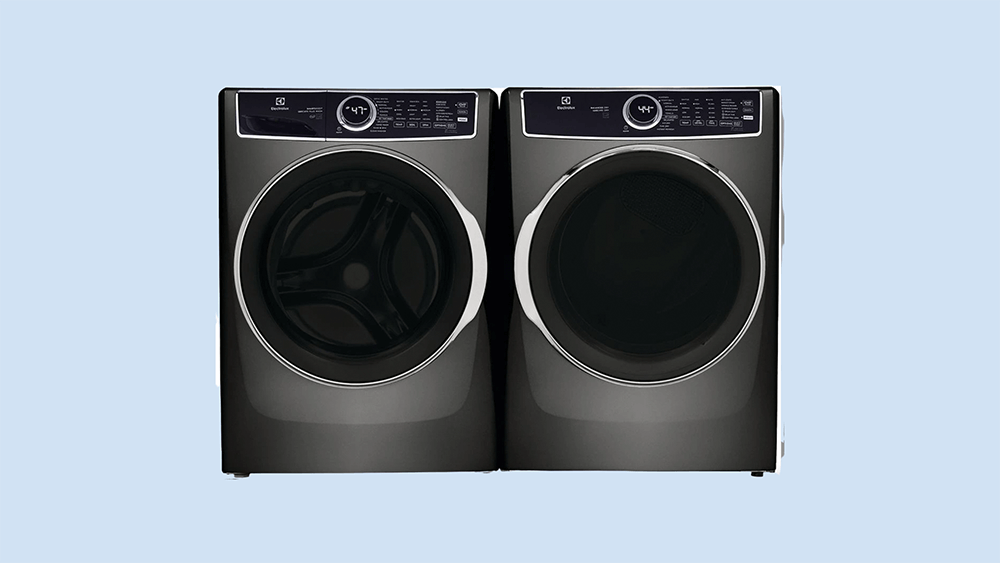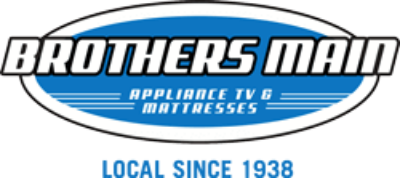Laundry Buying Guide: How to Choose a Washer and Dryer
Learn about product sizing, styles and other must-know topics to help you make an informed decision.

When it comes to doing laundry, an efficient washer and dryer can lighten your load for years to come.
Today’s laundry appliances range from tried-and-true classics to cutting-edge machines with the latest in technology and convenience. With so many choices, we’re here to help you find the best washer and dryer for your household.
We’ll go over product sizing, different washer and dryer styles and whether to replace one or buy a pair next time you’re in the market.
Selecting the Right Products for Your Space

Standard Washer and Dryer Sizes
Many factors will come into play as you shop for a new washer and dryer — including choosing models that will ultimately fit where they need to go.
The average size of a new washer or dryer varies depending on the style and brand. Learn more about average sizes below.
Top-load units:
• Width: 25-⅝ – 27 ½ inches
• Height: 42–44 inches
• Depth: 27–29 inches
Front-load units:
• Width: 27–29 inches
• Height: 39 inches
• Depth: 27.75–34 inches
Compact units:
• Width: 24 inches
• Height: 33–36 inches
• Depth: 24–26 inches
All-in-one laundry centers:
• Width: 24–27 inches
• Height: 74–79 inches
• Depth: 26–35 inches
Note: While these are good benchmarks for the average product size, you should still check your specific washer and dryer’s dimensions online or in-store.
Measure Twice, Deliver Once
Many new appliances are both taller and deeper than older models. Whether you're working with a dedicated laundry room, a closet or a spacious basement, be sure to measure the area before you shop.
When measuring the space your washer and dryer will need to fit into, keep the following adjustments in mind:
• Width: Leave 1–3 inches on each side of the appliance so air can circulate.
• Depth: Leave 4–6 inches at the back to accommodate vents, hookups and cords. Round vents will require more space than periscope-style vents. Front-load washers and dryers typically need 21–25 inches for the door to open.
• Height: For top-load washers, allow at least 20 inches for the door to open. If front-load models will be installed under a counter, leave 1 inch of wiggle room so they’re easier to remove when necessary.
Note: Adding pedestals to front-load units will increase height by about 15 inches. Unlike pedestals, stacking units do not add to height.
• Travel Path: Measure all doorways, hallways and tight corners that your washer and dryer will have to pass through to reach their install destination.
Lastly, take note of your utility installations — the water hookup and power outlet for the washer, the outlet (or gas hookup and outlet) and exhaust vent for the dryer — and where they are. Make sure their placement aligns with your plans.
Most standard connections, cords and drain hoses are only 4 feet long. If the drain is too far away, you may need a separate extension.
Washer and Dryer Types

Now comes the fun part – selecting the style. Here is a summary of each type of washer and dryer to get you started.
Top-Load Washers and Dryers
Traditional top-load washing machines have been the mainstay for decades, and are still a top pick among consumers. Consumers appreciate their familiar look, as well as the fact that they are cost effective and reliable. Top-load dryers are less common, as they are less efficient than their front-loading counterparts.
Inside a top-load washer, an agitator forms a central spindle the height of the washtub. During each wash load, the tub fills with water and the agitator moves the submerged items around through the water.
Pros:
• Usually the least expensive option
• Wash cycle times are typically shorter
• Minimal routine care and cleaning needed
• No bending or kneeling required to load and unload
Considerations:
• A lot of water usage
• Longer dry times, as clothes retain more water after washing
• Smaller capacities (typically less than 4.0 cubic feet)
• More wear-and-tear on clothing due to the washer’s central agitator
• Noisier than front-loaders
Shop: Traditional top-load washers and dryers
High-Efficiency Top-Load Washer and Dryers
High-efficiency top-loaders combine the utility-saving technologies of front-load units with a traditional exterior.
Instead of a central agitator sticking up on the inside of the washing machine, there is a short impeller wash plate that allows for more laundry capacity. During the wash cycle, sensors automatically determine the amount of water needed for each load – just enough to saturate the clothing. Similar to washing your hands by rubbing them together with soapy water, the wash plate causes the clothing to rub together for a thorough and resource-efficient wash.
Similar to traditional top-load dryers, high-efficiency top-load dryers are also rare.
Pros:
• More capacity than agitator top-loaders
• Less water usage than agitator top-load washers, shortening dryer time
• Faster spin speeds that reduce drying time and energy expenditure
• Gentler clothing treatment than an agitator top-load washer
• No bending or kneeling required to load and unload
Considerations:
• Higher price point than agitator top-load units
• High-efficiency detergent required
• Deep tubs can make it difficult to reach the bottom
• Laundry can tangle in washer because of low water level
• Some routine care and cleaning needed
High-Efficiency Front-Load Washers and Dryers
All front-load laundry units are high-efficiency. Because the drums of front-load machines sit sideways, the clothing inside tumble instead of twist. Like high-efficiency top-load washers, high-efficiency front-load washing machines automatically determine how much water is needed for each load.
Pros:
• Greatest potential for utility savings
• The most gentle option for fabrics
• Faster spin speeds and less water usage than agitator top-load washers, shortening dryer time
• Greater capacity than agitator top-loaders
• Best cleaning capability for bulky and extremely dirty items
• With the addition of an inexpensive stack kit, most can be stacked to save space
Considerations:
• Typically more expensive than top-load options
• High-efficiency detergent required
• Wash times are longer
• Some transmit vibrations to the floor, which could impact wood floors
• Bending or kneeling is required to load units (Note: A pedestal can help solve this)
• More care and cleaning needed than top-load models
Shop: High-efficiency top-load washers and dryers
Compact Washers and Dryers
Do you want the convenience of doing laundry at home but don’t have a lot of space? Roughly the size of a dishwasher, a compact washer and dryer may be your best bet.
Pros:
• Smaller in size, and most can be stacked to save additional room
• More gentle on clothes than agitator top-load units
• Usually water and energy-efficient
Considerations:
•Limited options available
• Generally more expensive than standard washers and dryers
• Cycle times can be long, especially for ventless models
• Cycle times can be long, especially for ventless models
Shop: Compact washers and dryers
Gas Vs. Electric Dryers
Before deciding on a gas or electric dryer, first check your hookups to determine what your home can accommodate.
Most laundry rooms come equipped with a 240-volt outlet for an electric dryer. If you have a gas hookup, you likely have the option to install either a gas or electric dryer.
Pros:
• More energy efficient than electric dryers
•Quicker dry cycles
•Use a standard electrical outlet
Considerations:
•Requires a gas hookup
• Must be placed near a vent that goes outside the home
• Often more expensive than a comparable electric dryer
Pros:
•More models to choose from
•Less expensive to buy up front
•Easier to fix issues yourself
Considerations:
•Requires a 240-volt outlet (see image below)
•Longer dry cycles
• Uses more electricity
All-in-One Washer/Dryers
If you have limited space, an all-in-one washer/dryer might be a good option. These units are almost always front-loading and tend to be slightly smaller than a standard single washer or dryer.
The most popular all-in-one product is a laundry center. Laundry centers are an efficient, space-saving alternative to stacking units. Unlike a stackable washer and dryer, a laundry center combines both appliances in one, placing the controls in between the sections.
Pros:
• Space-saving design takes up less room than traditional laundry pairs
•Centrally located controls make access easier
• Reduced bending and lifting required to load and unload
• Both gas and electric options available
• Generally less expensive than their stackable counterparts
Considerations:
•Malfunctions disrupt both washing and drying
• Smaller capacities than standalone units
• Fewer manufacturers to choose from
• Fewer features available
Shop: All-in-one washer/dryers
Energy Efficiency
All new washers and dryers are more efficient than models from a decade ago. However, energy efficiency varies by product model.
Compared to a top-load washer, front-load washers are 25% more energy and water efficient. Because they spin out more water, which significantly reduces drying time, front-load washers can make an even bigger difference in energy savings than buying a gas dryer.
The Environmental Protection Agency’s Energy Star rating is a good place to start when shopping for environmentally friendly options. It means that a product is in or around the top 25% of the market in terms of efficiency.
Information on a washer or dryer’s EnergyGuide label will help you go as green as possible. Use this label to determine the model's energy use, compare the energy use of similar models, and estimate annual operating costs.
Replace One or Buy a Pair?

If either your washer or dryer needs replacing, it's worth considering a matching washer and dryer set instead. And not just for aesthetics.
Because they’re designed to work together, a washer and dryer combo will take the guesswork out of compatibility. For example, an old dryer may be too small to manage the large amount of clothes held by a new washer. Likewise, using a new, high-capacity dryer alongside a smaller, older washer will waste energy by heating excess space in the dryer drum.
Moreover, many brands offer extra savings up front when you buy a washer and dryer together.
No matter which washer model you choose, refer to the product manual’s care and maintenance tips to help your appliance stand the test of time. All of the products we sell at Brothers Main come with a manufacturer warranty (typically one year) on parts and labor. To protect your purchase beyond the manufacturer warranty, Brothers Main offers more comprehensive protection plans with two, three and five-year terms from the date of delivery.
Find the Right Washer and Dryer for Your Home
At Brothers Main, we know it’s important to select a washer and dryer that not only cleans and dries clothes well, but won't let you down when you need them most. That's why we carry the most reliable brands of washers and dryers available.
If you’re still not sure what type of washer and dryer is right for you, don’t worry. The experts at our Madison and Janesville showrooms are happy to help find your perfect fit. We will consider factors including your laundry space, family size, desired features and available budget.





